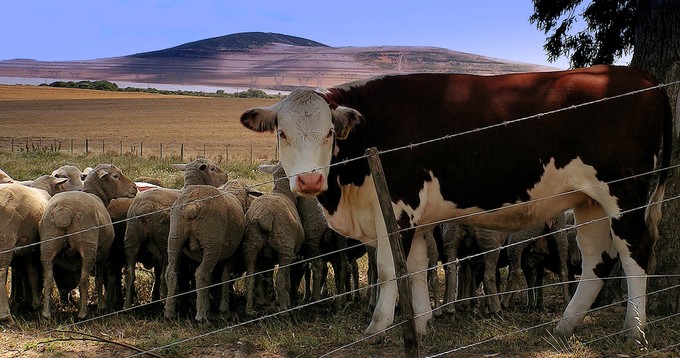
Cow and sheep on a South African farm. Photo via Wikipedia by Flickr user Lollie-Pop (CC BY 2.0).
13 January 2016
The skyrocketing price of both white and yellow maize during 2015 as well as estimates of only half of the usual crop sizes being planted for the 2016 season raise concerns for food price inflation.
According to the Pietermaritzburg Agency for Community Social Action’s (PACSA) monthly food price barometer, the price of 25 kg of maize meal increased from R147.82 in January 2015 to R181.81 in November 2015, a dramatic 23% increase.
Professor Beatrice Conradie who is an associate professor in the UCT School of Economics and is also the director of the Sustainable Societies Unit within the Centre for Social Science Research at UCT, says that prices are “generally formed on perceptions of the drought rather than facts about the drought” and that it “is not easy to say how much the drought contributed to the dramatic price increase” seen in PACSA’s data.
“Increases in the price of maize foodstuffs can to some extent be buffered by stockpiles, but the additional transport cost of imports will increase the price of processing,” she explains.
When asked about possible forecasts for maize prices during 2016 Conradie said that the maize system is very complex, meaning that forecasting precise prices is not easy.
“The ultimate price is jointly determined by demand and supply, and in the case of South Africa’s small open economy, this is global demand and supply,” said Conradie.
“Maize is food security,” says Professor Nick Vink, who is the chairman of the Department of Agricultural Economics at Stellenbosch University.
He too is hesitant to predict what will happen to the price of food this year. He says that the extent of a price increase depends on the product, with a large proportion of the price being attributed to packaging and other costs. The trading price of maize doubled in 2015. But, explains Vink, this does not necessarily translate into a doubling in food prices. The complex process from when seeds are planted to when the food arrives on our tables involves “hundreds of different actors,” he says.
In South Africa white maize is mainly used for human consumption and yellow maize for animal feed. One of the problems is that white maize is highly desired here, but it is not produced as widely internationally as its yellow counterpart, meaning that South Africa has few options to look to for importing it. The weak currency makes the situation worse.
It is not just the price of maize products that are set to rise. Conradie says that the drought will also affect the price of chicken, dairy and pork products as a large portion of maize goes into animal feed.
What is more, she says, is that small scale farmers will be “decimated” by the drought.
“Commercial farmers save up over decades and generations to be able to survive natural disasters. When a drought strikes, some farms shut down, and their owners survive on retirement money or look for jobs. This is the standard practice in the Karoo. In other cases farm operations are trimmed to core business until conditions are better,” she says.
Conradie says that when the drought ends, “orchards that died from the drought or livestock that had to be sold off, needs to be replaced. Some farms simply do not have the capital to survive this.”
All sectors of agriculture are affected by the drought, although it appears that field crops have been hit the hardest as they are usually grown without irrigation and mostly in South Africa’s summer rainfall areas where the drought has been the worst.
In the case of sheep farming in the Central Karoo, they have been experiencing drought for four out of the past five years.
Conradie says, “When I surveyed farmers in September and November 2015 a large proportion of them were already feeding their sheep, which adds enormous cost to their production system. Given the difficult conditions in the summer rainfall areas, it is probably the case everywhere. When it is dry, farmers have to feed their animals or market them. It means that for a while in the beginning of the drought meat prices might actually fall; however, once it rains again flocks have to be rebuilt which means that for a long while meat prices will remain relatively high.”
The effect of the drought on wheat production has been less catastrophic with most of South Africa’s wheat being produced in the Western Cape, which has not experienced the brunt of the drought.
An indicator of the severity of the drought is dam levels. Currently, the Gariep dam, the largest in the country, is only 49% full compared to 87% last year. Vanderkloof dam is at 73% capacity when last year it was at 94%, and Bloemhof is at 25% capacity with its 2015 level being 79%.
The drought can be attributed to El Nino, a phenomenon where ocean temperatures increase off the western coast of South America affecting global weather patterns. In December the South African Weather Service said that the El-Nino episode is expected to continue “towards the late summer season with the expectation to start gradually decaying during the autumn and early winter seasons”.
Vink warned that there are seldom two widespread dry years but that if this were to happen it “really kicks in as a disaster”.